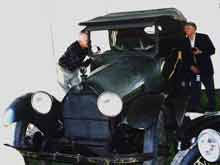Magnetic Personality
For all its popularity as an automobile powerplant, the internal combustion engine has one basic flaw: it develops its maximum power and torque in a relatively narrow band of engine speeds - and no power at all when it's not rotating. Making the engine useful in a car requires multiple ratios of gears, belts or disks, each of which has drawbacks. Thus the automobile did not become a true consumer good until the advent of the modern automatic transmission.
Justus B. Entz had a solution to this problem as long ago as 1897. In that year he invented an electromagnetic transmission, in some ways similar to the drive mechanism used on today's diesel-electric locomotives. An internal combustion engine drives a generator, and the electricity generated powers an electric motor to drive the wheels. Entz's transmission was put into production in the Owen Magnetic, "The Car of a Thousand Speeds," introduced at the New York Auto Show in January 1915. Built by the Baker, Rauch & Lang Co. from 1915-21, it was produced in factories at New York, Cleveland, Ohio, and Wilkes Barre, Pennsylvania.
The late Edwin Jameson, Sr., apparently thought this was a good idea, for in 1918 he purchased a new Owen Magnetic touring car. In fact, he thought it was such a good idea that he bought two: the tourer, seen here with Dale Wells (left) and Leroy Cole, both past presidents of the Society of Automotive Historians, and also a roadster. Dale and Leroy were entranced with the Floyd Clymer-style through-the-windshield spotlight with which this car is fitted. Driving an Owen was truly a one-foot adventure.
Both cars, which had remained in the Jameson family, were sold at a Bonhams and Butterfields auction at the Larz Anderson Auto Museum in Brookline, Massachusetts, in May 2003. The tourer, knocked down at $36,000 (plus buyer's premium), is now being restored by a British owner. The roadster, which sold for $24,000 plus-premium, went to an undisclosed location. Interestingly, the Entz transmission itself ended up in England after the demise of the Owen Magnetic. Ensign Motors, Ltd. of London adopted it for a model of their British Ensign car, sold as the Crown Magnetic (later Crown Ensign) from 1921-23 (photo thanks to Mike Worthington-Williams).

